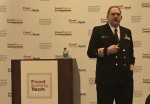The recent Foods Lab Conference (co-located with Pittcon) was an intersection of compliance, technology and best possible practices. One of the goals of this international symposium was to have laboratories and the food industry recognize one another as part of an effort for a more intentional and collaborative system in the industry, especially in terms of policies and practices.
As a Food Science student from Tallahassee, Florida I ended up at this incredible conference after seeing a blurb for it on LinkedIn and was able to attend as an intern. The two main objectives of my role were to assist with various tasks to help ensure the event transitioned smoothly, as well as further my knowledge base of the enormous realm of food safety. The following are some themes that I heard throughout the two days.
Having the analysis and validation performed or overseen with preventative types of controls from a qualified individual should ideally occur before the food safety plan is implemented. This appears to be desired by the consensus and was a common thread during the conference. If there is a change in a process control, it can have a serious impact on the legitimacy of the documentation if the change is not taken into account. The ISO implementations are food safety management systems and hazard analysis identification, which is the international benchmark for compliance standards.
Analytical scientific instrumentation is absolutely necessary for guaranteeing data and reproducibility on a consistent basis. The scope and complexity of modern technology should be considered when used for repeated trials in which the narrowest margins of results are being demanded by consumers and industry. Microbiologists confirm their peace of mind is reliant on the ability for reproducible experimental trials. In a laboratory, the presence of variables and species must be handled in an extremely controlled manner. All too frequently undesirable organisms appear in foods, and this is often the result of poor food handling practices, fraudulent practices or summed up, lazy shortcuts for the most unthinkable reasons. An effort to decrease these microbes is being made through transparency in supply chains to trace the journey of the food from seed to the table.
Food production is being shaped as a result of FSMA, which is a milestone in food safety. A few features of this legislation are to offer assistance for the food technology sector and address questions about policy and safe handling practices. It has and will continue to influence the process of laboratory accreditation, validation and compliance in order to provide thorough transparency for the development of more modern food systems. There were many fascinating perspectives shared about validation and accreditation for both laboratories and facilities. Many large companies have their laboratories in-house, because it is easier from a production perspective if the product is going to market, to test it repeatedly in order to have less delay in the market launch. There have been times in which carcinogenic fillers or fake foods were portrayed. Examples would be the horse meat and melamine scandals. An additional perspective would be the possibility in protecting the own interests of the company by not disclosing true ingredients, practices, or actual comprehensive food safety evaluation. All are truly unacceptable with regards to mega food base distribution companies. Small- to medium-sized businesses typically source laboratory evaluations to third-party assessors to perform product validation because it’s simply too expensive to implement on their own because of labor, technology and space constraints. Claims of 100% pure olive oil are not true the majority of the time. A sunflower oil and chlorophyll solution can be made to mimic the coloration of pure extra virgin olive oil. So it is commonplace for this sort of solution to be created and combined with pure olive oil at a ratio of 2:1, as a conservative figure. True wording and claims are becoming a thing of the past, because it is way too simple for big food business to engage in such unthinkable practices to maximize their own profits.
A key thread running throughout the conference was the importance of necessitating the collaborative efforts needed to achieve a comprehensive dialogue set in place as a universal type of database. This database would serve as the foundation to ensure safe food practices throughout worldwide food production companies, accredited laboratories, governments, and consumers.
The Food Labs Conference was truly one of fantastic speakers, interesting participants, and fascinating conversation. The advanced topics were explored by professionals who share a deep passion for this vital industry sector. Food Laboratories and the conference, respectively, will become even more revolutionary in terms of future technology, the influence garnered by key publics, and future experts.






















